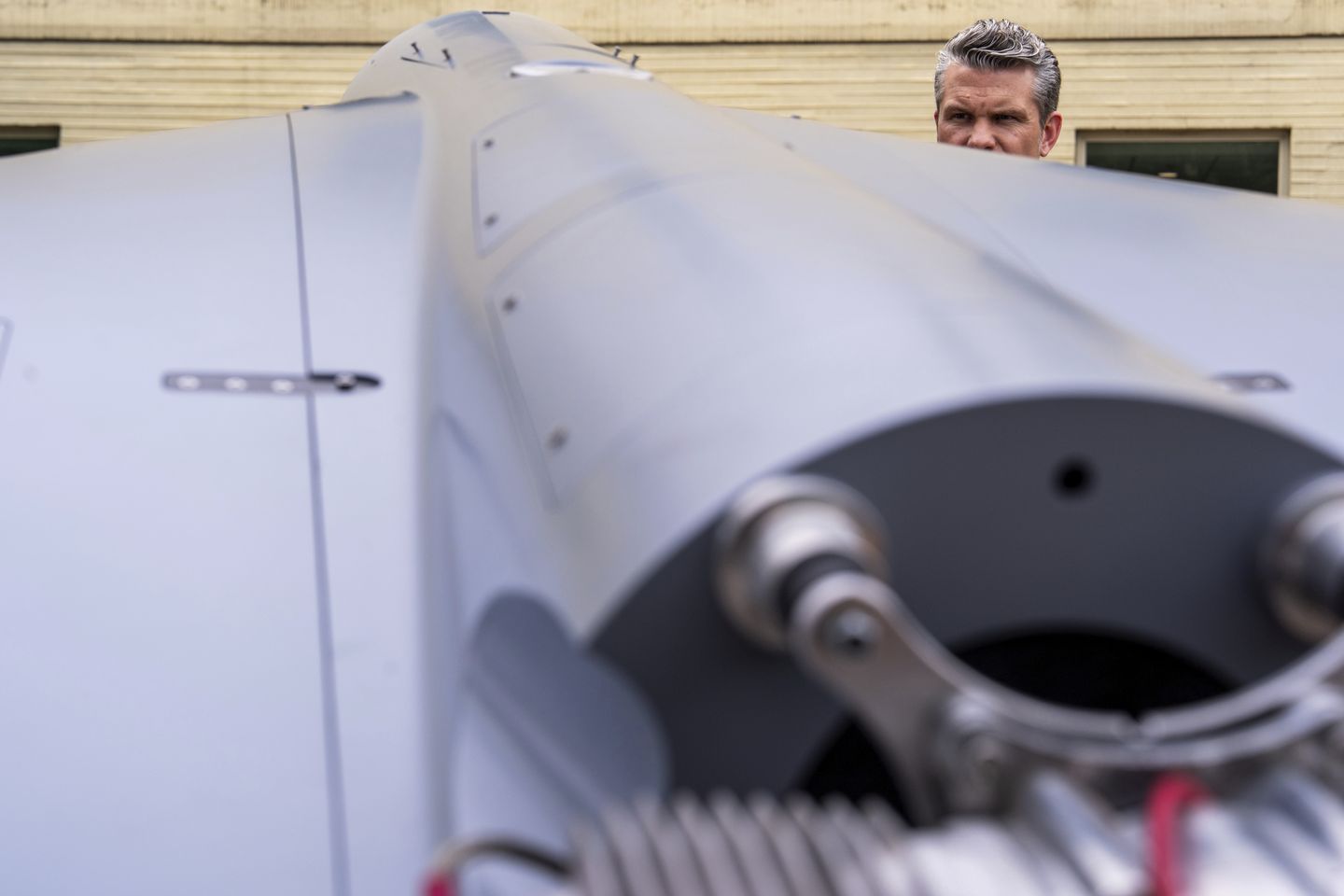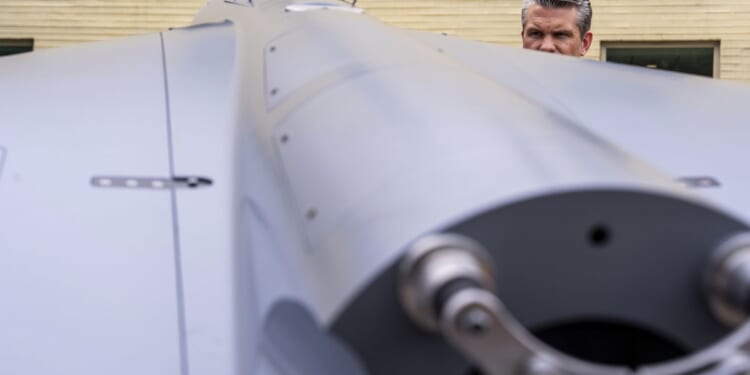
The Pentagon’s secretive Replicator program isn’t about drones, at least not entirely.
If it was, it’s fallen short of its goal: fielding “multiple thousands” of attritable autonomous systems by August 2025. The exact number is classified, but the initiative seems to have fielded only hundreds, not thousands, by the target date.
Replicator’s proponents say it has succeeded in its broader — and arguably more important — mission to spark major changes in how the Defense Department procures and fields cutting-edge systems like modern-day drones and the speed with which it delivers 21st-century technology to warfighters in key theaters, especially the Indo-Pacific.
Former leaders of the Pentagon’s Defense Innovation Unit (DIU), including Doug Beck, the former Apple executive who led the secretive unit for years, say that Defense Secretary Pete Hegseth is now embracing those broader changes on an even grander scale.
“The focus of DIU over the past few years — working with partners across the department, the tech sector, Congress, and our allies and partners — has been about two things. First, delivering concrete capability to the warfighter with the focus, speed and scale necessary to deter major conflict or win if forced to fight, and, second, helping the department as a whole to build the muscle necessary to do that again and again at the greater and greater scale the strategic imperative demands,” said Mr. Beck, who resigned in August from DIU, which oversaw Replicator during its formative period.
Mr. Hegseth last week delivered an hour-long speech laying out an overhaul of the Pentagon’s acquisition process with a heavy emphasis on “speed and volume,” echoing the goals inside the DIU, which was launched in 2015 to accelerate the adoption of commercial technology by the military.
After the speech, Mr. Beck told The Washington Times in his first public comments since leaving DIU that Mr. Hegseth’s announcements were “a clear indication of how serious the secretary and his team are about taking that transformation to the next level, and I look forward to seeing it become a reality.”
Replicator’s ultimate success, in addition to its mandate to field both huge numbers of drones and counter-drone systems, might be judged by whether Mr. Hegseth’s Pentagon follows through on the secretary’s stated goals.
If the department does in fact transition from an acquisition system that virtually all stakeholders agree is far too slow and bureaucratic to a more rapid blueprint that quickly fields new technology, Replicator and the work of DIU are likely to be viewed by history as powerful accelerants that helped it get there.
The story of the program over its 27-month existence is one of near-unprecedented ambition. But its progress was sometimes slowed by behind-the-scenes turf wars and Pentagon infighting, as well as frustration among some defense industry titans who believed the DIU was biased in favor of Silicon Valley upstarts.
Now, the structures that supported Replicator are flagging, and its tangible goals are unmet, all while the Trump administration undertakes its own new initiatives to accelerate the Pentagon’s acquisition of drones and other technologies.
The Pentagon declined to comment for this article, which is based on interviews with a dozen sources, from current and former defense officials to defense industry leaders who worked directly with Replicator. Some of those sources were granted anonymity to speak openly about one of the most secretive Pentagon programs in decades to put America’s drone industrial base at a wartime-level pace of production.
Replicator’s mission
Former Deputy Defense Secretary Kathleen Hicks announced the creation of Replicator in August 2023. From its inception, the initiative was a central piece of the U.S. military’s plan to keep pace with and beat an adversary, China’s People’s Liberation Army, that is making its own historic strides in the development and fielding of massive numbers of autonomous drones.
“We’ll counter the PLA’s mass with mass of our own, but ours will be harder to plan for, harder to hit and harder to beat,” Ms. Hicks said at the time.
Defense industry leaders whose companies worked with the Replicator program say there’s no debate that small, cheap, easy-to-produce drones have radically changed modern-day warfare.
That change has been on full display in the Russia-Ukraine war. Ukraine in particular has brought rapidly innovated drones, some literally constructed in garages in a do-it-yourself manner, into the fight.
U.S. dronemakers have watched and learned.
“Small drones are really disruptive to how things have been done in the past. This is the biggest change in military doctrine since armor went across the front lines in World War I,” said Ryan Gury, co-founder and CEO of the Huntsville, Ala.-based dronemaker PDW.
“In my opinion, we have not seen this type of disruption in ground forces for a long time. You can hit a target 20 miles away from under the cover of your foxhole,” Mr. Gury said in an interview. “With a small quadcopter, the idea of precision fires or the idea of anti-tank guided missiles … or an anti-personnel change, you are dominating precision and 3D environments like nothing that’s ever been done before.”
PDW’s C-100 unmanned aerial system and Anduril’s Ghost-X were awarded Replicator contracts as part of the program’s second wave, or “tranche,” in November 2024. The first tranche saw a significant contract awarded to AV, maker of the Switchblade-600 loitering munitions system, which has been used extensively in Ukraine.
Zone 5, L3Harris, Swarm Aero, and a host of other American companies have also secured Replicator contracts, some for physical drone bodies and some for the associated software and other components.
Overall, sources said that about two-thirds of DIU’s work, including with the Replicator program, has been with small- and medium-sized businesses, with about one-third of those firms new to the defense industry. The remaining one-third is with larger companies, and about 10% of that with the traditional “primes” in the defense industry.
One former Replicator official said tension between new defense contractors and traditional firms was an expected consequence of the goals of Replicator, though companies from both of those camps have secured contracts through the program.
The military’s natural lack of ability to “take more risks” pushed it toward “big, entirely gorgeous systems that are exquisite and can do a lot of things,” but lacked the flexibility to “adapt and do things that are low cost, just good enough,” the official said.
A few months into the program, Ms. Hicks said that the Pentagon would spend $1 billion total on the program in fiscal years 2024 and 2025. The Pentagon has not responded to requests by The Times for comment on the total amount of Replicator contracts awarded so far.
The program has been evolving since its inception. Replicator 1.0 focused on drone systems. Replicator 2.0, announced in September 2024, was aimed at building counter-drone systems.
Early this year, Mr. Hegseth shifted the Replicator 2.0 program into the U.S. Army’s newly-created Joint Interagency Task Force 401. Defense sources say the focus is on developing counter-drone systems that would be crucial in future fights, including a potential Pacific clash with communist China and its drones.
The sources told The Times that the first iteration of Replicator, and its specific military goals, were sketched out in direct collaboration with U.S. Indo-Pacific Command.
The command’s leader, Adm. Samuel Paparo, has spoken publicly about his vision of using drones to create a “hellscape” in and around the Taiwan Strait — an aerial battlefield so crowded and deadly that it’s nearly impossible for the PLA to operate there. That vision necessitates a U.S. drone industrial base that can churn out huge numbers of drones in short order.
While DIU oversaw the program for its formative years, Replicator earlier this year was moved into the portfolio of U.S. Special Operations Command (SOCOM) and its Defense Autonomous Warfare Group.
That was a divisive move among defense insiders. Several told The Times that Replicator’s core purpose was to demonstrate how innovation and rapid fielding of capabilities could yield benefits across the U.S. military. But by moving it to SOCOM, those sources said, the program’s accessibility to all services was under threat of being curtailed.
Others argued that SOCOM has long been a leader in battlefield development. It has ingrained the idea in its culture, going so far as to name one of its Tier 1 units “Development Group” — also known as SEAL Team 6.
’Only hundreds’ of drones so far?
With the actual drone production goal of Replicator 1.0 classified and closely guarded inside the Pentagon, it’s difficult to say definitively how the program has fared from a purely numbers standpoint. Some top defense industry executives, whose companies have Replicator contracts, said even they were not told of the specific target figure.
A September Congressional Research Service report indicated that the “multiple thousands” goal has not been achieved.
“Although Replicator was intended to field thousands of uncrewed systems by summer 2025, one former defense official noted that DoD had fielded only hundreds by that time,” the report said. “Lack of information on Replicator, either in the classified or unclassified realms, has the potential to raise doubts about whether DoD has adequately analyzed the initiative in terms of capabilities and costs.”
There could be several reasons for a lag in production. Some defense industry sources said that despite DIU’s best efforts, the current acquisition process made it difficult, if not impossible, to move from contract awards to actual fielding in the time frame laid out by Ms. Hicks.
Other sources pointed a finger at what they described as DIU’s prioritization of firms new to the defense industry, some of which only had products in the prototype phase that couldn’t be delivered quickly.
Sources suggested production at some manufacturing centers may have been impacted by recent natural disasters, including wildfires in California.
Another former defense official flatly blamed the Trump administration, asserting the administration viewed Replicator as “an extremely low priority” when it assumed power earlier this year. That official said the program was seen as a Biden-era initiative, and that political considerations led to it being at least temporarily pushed to the back burner.
Another former Defense official said that during the changeover in administrations, DIU, which had some purchasing authority under the program, had to make its own drone purchases to make up for declines in buys made by military services.
The path forward
Regardless of the Trump administration’s initial posture toward Replicator, the goal of rapidly producing more innovative drones for U.S. military use now appears to be a central priority for Mr. Hegseth.
The White House, Republican-controlled Congress, and the military are now attempting to shift the way defense procurement is done writ large.
This year’s National Defense Authorization Act is squarely aimed at cutting red tape for new entrants and providing additional resources to the different military services to bring in new technology, according to the text of the bill passed separately by the House and the Senate.
It remains to be seen what the final version of the bill, expected next month, will look like.
In his speech last week, Mr. Hegseth emphasized the need to slash internal red tape in the Pentagon’s weapons acquisition process.
“Speed and volume will rule,” he told an audience of private defense industry leaders gathered at the National War College in Washington.
The secretary specifically announced the cancellation of the Joint Capabilities Integration and Development System, the traditional acquisition requirements system inside the Defense Department. In its place, the Pentagon will establish three decision forums to expedite the requirements process, including a funding pool to purchase and immediately implement “promising solutions” for warfighters.
But the Replicator saga underscores how some fundamental issues may remain at play within the new structures being established by Mr. Hegseth.
Under Replicator, sources described tensions between DIU and other stakeholders, including military services that traditionally had taken lead roles in procurement and the fielding of new systems.
“It was caught in between multiple departments. It was led by DIU but all the services had to contribute to it and play ball with it, so to speak. And DIU was not really well-liked by some of the services. It’s still not,” one high-level defense industry source told The Times. “There’s a perception out there that … DIU has not been a very successful endeavor, as an entity.”
“It’s really hard when you have an institution built already and has all these different disciplines, practices, processes, rules, organizational structures, and then you build another entity on the side and you want it to be successful, and in some respects it’s not integrated really well to begin with,” the source said, referring to the creation nearly a decade ago of the DIU.
“You’re setting yourself up for a lot of challenges,” the source said. “That’s probably why DIU has a bad reputation. And they are quite biased toward Silicon Valley. And Silicon Valley tells a very good story. I’d say they’re very good at marketing. Deliverables have been lacking. That’s the fact.”
Now, not only is Replicator losing steam, but the DIU itself may be as well, even as the department puts a premium on the type of developments the unit had been focused on.
The Defense Innovation Steering Group as well as the Industry Innovation Working Group, both of which included representatives from the DIU and other areas of the Pentagon, appear to have been sidelined as Mr. Hegseth pushes his own new initiatives.
Going forward, there are questions about how the new initiatives will harness input from across the force to develop resources, and inexpensive technologies that would be useful for both commercial and defense purposes.
One of the former officials who spoke with The Times said the DIU purpose was to “make lots of little bets on things to see what sticks.”
“It was a way to show that with senior leadership and focus you can kind of put your foot on the gas and scale these capabilities,” they said. “Seeing what’s happening to it now makes me sad.”










